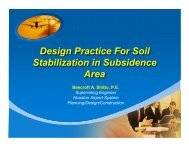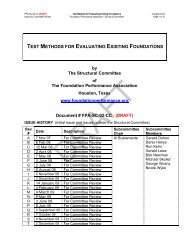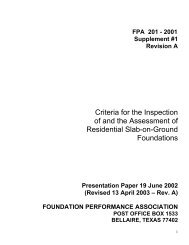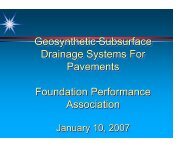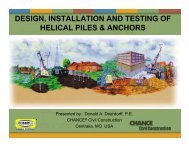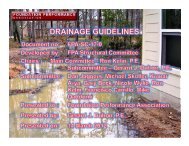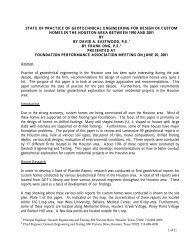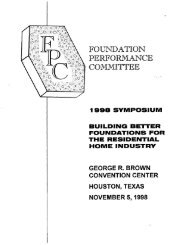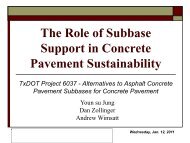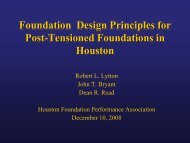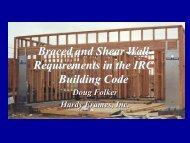Soil-Structure Interaction Seminar - Foundation Performance ...
Soil-Structure Interaction Seminar - Foundation Performance ...
Soil-Structure Interaction Seminar - Foundation Performance ...
Create successful ePaper yourself
Turn your PDF publications into a flip-book with our unique Google optimized e-Paper software.
The borings for the residential lots should be performed after the streets are cut and fill soils<br />
have been placed and compacted on the lots. This will enable the geotechnical engineer to<br />
identify the fill soils that have been placed on the lots. All fill soils should have been tested for<br />
compaction during the placement on the lots. A minimum of one density test for every 2500<br />
square feet per lift must be performed once a subdivision is being developed. Fill soils may<br />
consist of clays, silty clays, and sandy clays. Sands and silts should not be used as fill materials.<br />
Typical structural fill in the Houston area consists of silty clays and sandy clays (not sands) with<br />
liquid limits less than 40 and plasticity index between 8 and 20. The fill soils should be placed<br />
in lifts not exceeding eight-inches and compacted to 95 percent of the maximum dry density<br />
• (ASTM D698-91).<br />
In the case of a subdivision development, the developer should perform only the borings for the<br />
streets and underground utilities. The borings for the lots should wait until all fill soils from<br />
street and underground utility excavations are placed and compacted on the lots. In g€neral, the<br />
geotechnical• testing of the soils for the lots should be the builders responsibility. We<br />
recommend that all of the foundations in the subdivision be engineered by a registered<br />
professional engineer specializing in residential foundation design.<br />
In the areas where no fill will be placed on a lot prior to site development, the borings on the<br />
lots can be performed at the same time as the time as the borings for streets. The soils data<br />
from the street and underground borings should never be used for the slab design. This is due<br />
to potential in variability in the soil conditions, including soils stratigraphy, compressibility,<br />
strength, and swell potential.<br />
<strong>Soil</strong> borings must be performed prior to foundations underpinning for distressed structures. This<br />
is to evaluate the subsoil properties below the bottom of the drilled footings. The depth of<br />
drilled footings for foundation underpinning should be determined by a geotechnical engineer.<br />
Unfortunately, this is not always followed, and many "so called" foundation repair jobs are<br />
performed incorrectly, causing significant financial loss for the client.<br />
In the event of building additions, a minimum of one boring is recommended on residential<br />
additions of less than 1,000 square feet. A minimum of two borings is recommended for<br />
additions greater than 1,000 square feet.<br />
In general, a scope of typical geotechnical exploration does not include the evaluation of fill<br />
compaction. These studies should have been performed at the time of fill placement.<br />
GEOTECH ENGINEERING AND TESTING, INC. ____________ _.<br />
11



